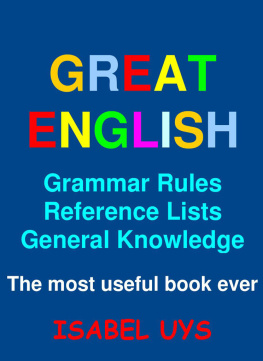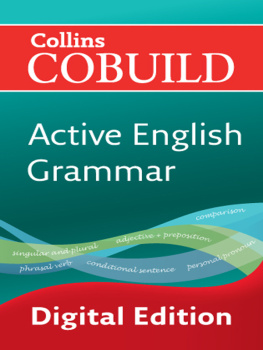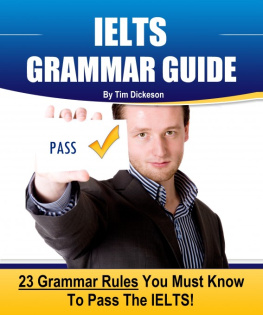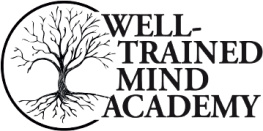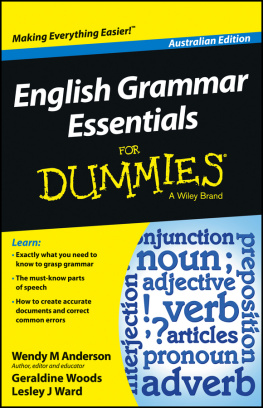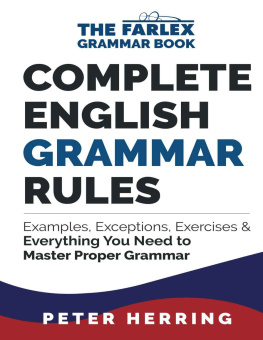Isabel Uys - Great English: Grammar Rules, Reference Lists and General Knowledge
Here you can read online Isabel Uys - Great English: Grammar Rules, Reference Lists and General Knowledge full text of the book (entire story) in english for free. Download pdf and epub, get meaning, cover and reviews about this ebook. year: 2017, genre: Detective and thriller. Description of the work, (preface) as well as reviews are available. Best literature library LitArk.com created for fans of good reading and offers a wide selection of genres:
Romance novel
Science fiction
Adventure
Detective
Science
History
Home and family
Prose
Art
Politics
Computer
Non-fiction
Religion
Business
Children
Humor
Choose a favorite category and find really read worthwhile books. Enjoy immersion in the world of imagination, feel the emotions of the characters or learn something new for yourself, make an fascinating discovery.
- Book:Great English: Grammar Rules, Reference Lists and General Knowledge
- Author:
- Genre:
- Year:2017
- Rating:3 / 5
- Favourites:Add to favourites
- Your mark:
- 60
- 1
- 2
- 3
- 4
- 5
Great English: Grammar Rules, Reference Lists and General Knowledge: summary, description and annotation
We offer to read an annotation, description, summary or preface (depends on what the author of the book "Great English: Grammar Rules, Reference Lists and General Knowledge" wrote himself). If you haven't found the necessary information about the book — write in the comments, we will try to find it.
Isabel Uys: author's other books
Who wrote Great English: Grammar Rules, Reference Lists and General Knowledge? Find out the surname, the name of the author of the book and a list of all author's works by series.
Great English: Grammar Rules, Reference Lists and General Knowledge — read online for free the complete book (whole text) full work
Below is the text of the book, divided by pages. System saving the place of the last page read, allows you to conveniently read the book "Great English: Grammar Rules, Reference Lists and General Knowledge" online for free, without having to search again every time where you left off. Put a bookmark, and you can go to the page where you finished reading at any time.
Font size:
Interval:
Bookmark:
GREAT ENGLISH Grammar Rules Reference Lists General Knowledge The most useful book ever by Isabel Uys Sections of this book was formerly published under the title English . However, most of the sections are greatly enlarged, lots of new information, interesting facts and a new second part, consisting of useful general knowledge facts, have been added. Copyright 2017 Isabel Uys All rights reserved. No portion of this book may be reproduced mechanically, electronically, or by any other means, including photocopying, without the permission of the author. To all the users of this book. I hope it will save you many hours of searching for information.
ABOUT THE AUTHOR Isabel Uys is well established as one of South Africas leading authorities on reference books, dictionaries and language aids. She has many years teaching experience and worked for five years as a book selector for The Western Cape Education Department. She has compiled numerous reference books, multilingual dictionaries and language aids. Many of them were best-sellers. She won two literary awards. Her first book was published in 1994 and is still in print (more than 24 updates).
Her aim is to compile practical and useful books for children and adults. INTRODUCTION Parents, learners, students, teachers, writers, everyone! This is the book you have been waiting for! There is no similar book available anywhere. This book is not an ordinary grammar guide. It is also a comprehensive reference book with long lists of grammar which is frequently required and some very useful general knowledge. Instead of searching for information in various sources, you will find most of the information needed in this single volume. Although this book is not aimed at serious grammarians, it provides all the information needed to use English grammar and punctuation properly.
The information varies from simple to more advanced. The grammar rules are clearly explained. A great asset is the comprehensive reference lists which are not found in other study aids. There are more than 1,600 plurals in the book. Please see the Table of Contents. The general knowledge section provides lots of useful facts.
This book is an excellent resource for anyone who wishes to learn correct grammar and punctuation. It is also suitable for young learners and a good tool for doing homework or preparing for exams. Yes, the most useful book ever! CONTENTS Part I Language and grammar Part II General knowledge 1. THE ALPHABET An alphabet is a group of letters used to form words. Many different alphabets are used in the world. The English alphabet is based on the Latin (or Roman) alphabet.
The English alphabet is the most commonly used alphabet in the world. There are 26 letters in our alphabet. It is necessary to know the alphabet to find information and words easily. Information and words are usually arranged in alphabetical order The five vowels in our alphabet are a , e , i , o , u . All the other letters in the alphabet are consonants. a b c d e f g h i j k l m n o p q r s t u v w x y z How to arrange words alphabetically ball, apple, great, bed, above, river, actor, kitchen, break 1.
Find all the words that start with an a . (apple, above, actor) 2. Now look at the second letter and see which second letter comes first in the alphabet. (above) 3. Continue with the third letter in the word until you have arranged all the letters starting with an a . (above, actor, apple) 4.
When you have arranged all the words starting with an a , you start with the words starting with a b . 5. Therefore the alphabetical order of the words at the top are: above, actor, apple, ball, bed, break, great, kitchen, river If two people have the same name or initials, but different surnames, look at the surnames to place them in alphabetical order. (John B rown, John K elly, John S mith) In a dictionary two words are printed at the top of every page to show the first and last word on that page.
Interesting facts: For many years, people wrote without any letters. They drew pictures (hieroglyphics) to make their point.
Hieroglyphs used in Ancient Egypt  In recent times pictures are still used to make information understandable to all people.
In recent times pictures are still used to make information understandable to all people.  The word alphabet comes from the first two letters of the Greek alphabet, alpha and beta. Originally the Greeks used only capital letters. The second most widely used alphabet in the world is the Arabic alphabet. The most frequently used letter in the English Alphabet is the e . The Braille alphabet for the blind was invented in 1821 by a blind Frenchman, Louis Braille.
The word alphabet comes from the first two letters of the Greek alphabet, alpha and beta. Originally the Greeks used only capital letters. The second most widely used alphabet in the world is the Arabic alphabet. The most frequently used letter in the English Alphabet is the e . The Braille alphabet for the blind was invented in 1821 by a blind Frenchman, Louis Braille.
The Braille alphabet is a system of raised dots that can be "read" with the fingers. The Braille alphabet  2. NUMERALS/NUMBERS The number system that we use is the base 10 (Arabic) system Cardinal numbers tell you how many things there are. ( ten children) Ordinal numbers tell you the order of something. (the second child)
2. NUMERALS/NUMBERS The number system that we use is the base 10 (Arabic) system Cardinal numbers tell you how many things there are. ( ten children) Ordinal numbers tell you the order of something. (the second child) 
 A comma is used to separate every three digits.( 1,000,000 ) A comma is inserted every three digits from the right. (twenty-seven; fifty-six) A period/full stop is used as a decimal mark.( 10.8 kg ) Note: Some countries use a space to separate the digits and a comma as a decimal mark. ( 1 000 000 and 10,8 kg ) Rules for writing numbers There are different styles for writing numbers. ( 1 000 000 and 10,8 kg ) Rules for writing numbers There are different styles for writing numbers.
A comma is used to separate every three digits.( 1,000,000 ) A comma is inserted every three digits from the right. (twenty-seven; fifty-six) A period/full stop is used as a decimal mark.( 10.8 kg ) Note: Some countries use a space to separate the digits and a comma as a decimal mark. ( 1 000 000 and 10,8 kg ) Rules for writing numbers There are different styles for writing numbers. ( 1 000 000 and 10,8 kg ) Rules for writing numbers There are different styles for writing numbers.
These rules are the ones most often used. It is important to be consistent within the same page or document. 1. Sentences may not start with figures, unless it is a calender year (2018). 2016 was a memorable year in American politics.( correct ) Twenty-five people died in the attack. ( wrong ) One percent of the grade four learners failed. ( correct ) 1%/1 percent of the grade four learners failed. ( wrong ) 2. ( wrong ) 2.
Numbers from one to nine in a sentence are always written in letters. Only six people attended the meeting. ( correct ) Only people attended the meeting. ( wrong ) 3. Numbers from one to nine used in calculations, lists or measurements are written in figures. x = 24 (correct) .
Peter Lewis ( correct ) . James Marsh ( correct ) He is 2.2 m tall. ( correct ) 4. Be consistent when there are two numbers in the same sentence . There were five boys and sixteen girls at the party. ( wrong ) Note: It can be confusing when two numbers are used next to each other. ( wrong ) Note: It can be confusing when two numbers are used next to each other.
Write the shortest number in figures. There are five 12-year old girls and seven 13-year old boys in the group. ( correct ) There are 12-year old girls and 13-year old boys in the group. ( wrong ) Note: Some style guides recommend spelling out the numbers one to one hundred. 5. Large numbers are written in figures, but if the number is not precise , it may be written in words .
All survivors were taken to hospitals. ( correct ) All six hundred (and) fifty survivors were taken to hospital. ( wrong ) More than six hundred (and) fifty survivors were taken to hospitals. ( correct not precise) 6. When writing round numbers that are larger than a million , use figures followed by the word "million", etc . More than 3 million animals were affected by the drought.( correct ) Oprah Winfrey earned $315 million each season for her show.( correct ) 7.
Next pageFont size:
Interval:
Bookmark:
Similar books «Great English: Grammar Rules, Reference Lists and General Knowledge»
Look at similar books to Great English: Grammar Rules, Reference Lists and General Knowledge. We have selected literature similar in name and meaning in the hope of providing readers with more options to find new, interesting, not yet read works.
Discussion, reviews of the book Great English: Grammar Rules, Reference Lists and General Knowledge and just readers' own opinions. Leave your comments, write what you think about the work, its meaning or the main characters. Specify what exactly you liked and what you didn't like, and why you think so.

